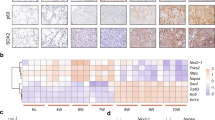Abstract
Arsenic is a well-known human carcinogen. However, the mechanisms underlying arsenic-induced carcinogenesis remain elusive. Here we show that chronic and low level of arsenic stress induces transformation of the human bronchial epithelial cells, BEAS-2B, and that some of the transformed cells show characteristics of cancer stem-like cells (CSCs). Meanwhile, we demonstrate that arsenic stress dedifferentiates CD61+ BEAS-2B cells into CSC-like CD61− cells featured with noncanonical epithelial–mesenchymal transition (EMT), enhanced chemoresistance, and metastasis. Finally, we show that oncogene c-Myc expression is associated with arsenic-induced tumor initiation and progression. Altogether, our findings highlight a unique mechanism of arsenic-induced transformation of human bronchial epithelial cells and provide a novel therapeutic target for arsenic-initiated lung cancer.
Access this chapter
Tax calculation will be finalised at checkout
Purchases are for personal use only
Similar content being viewed by others
References
Lubin JH, Beane Freeman LE, Cantor KP (2007) Inorganic arsenic in drinking water: an evolving public health concern. J Natl Cancer Inst 99(12):906–907
Li L et al (2019) Metabolic and epigenetic reprogramming in the arsenic-induced cancer stem cells. Semin Cancer Biol 57:10–18
Liu J, Waalkes MP (2008) Liver is a target of arsenic carcinogenesis. Toxicol Sci 105(1):24–32
Jemal A et al (2011) Global cancer statistics. CA Cancer J Clin 61(2):69–90
Sun S, Schiller JH, Gazdar AF (2007) Lung cancer in never smokers-a different disease. Nat Rev Cancer 7(10):778–790
Mead MN (2005) Arsenic: in search of an antidote to a global poison. Environ Health Perspect 113(6):A378–A386
Guo HR (2004) Arsenic level in drinking water and mortality of lung cancer (Taiwan). Cancer Causes Control 15(2):171–177
Clarke MF et al (2006) Cancer stem cells-perspectives on current status and future directions: AACR Workshop on cancer stem cells. Cancer Res 66(19):9339–9344
Chang Q, Chen B, Thakur C, Lu Y, Chen F (2014) Arsenic-induced sub-lethal stress reprograms human bronchial epithelial cells to CD61 cancer stem cells. Oncotarget 5(5):1290–1303
Lapidot T et al (1994) A cell initiating human acute myeloid leukaemia after transplantation into SCID mice. Nature 367(6464):645–648
Bonnet D, Dick JE (1997) Human acute myeloid leukemia is organized as a hierarchy that originates from a primitive hematopoietic cell. Nat Med 3(7):730–737
Al-Hajj M, Wicha MS, Benito-Hernandez A, Morrison SJ, Clarke MF (2003) Prospective identification of tumorigenic breast cancer cells. Proc Natl Acad Sci U S A 100(7):3983–3988
O'Brien CA, Pollett A, Gallinger S, Dick JE (2007) A human colon cancer cell capable of initiating tumour growth in immunodeficient mice. Nature 445(7123):106–110
Singh SK et al (2004) Identification of human brain tumour initiating cells. Nature 432(7015):396–401
Eramo A et al (2008) Identification and expansion of the tumorigenic lung cancer stem cell population. Cell Death Differ 15(3):504–514
Barker N et al (2009) Crypt stem cells as the cells-of-origin of intestinal cancer. Nature 457(7229):608–611
Krivtsov AV et al (2006) Transformation from committed progenitor to leukaemia stem cell initiated by MLL-AF9. Nature 442(7104):818–822
Driessens G, Beck B, Caauwe A, Simons BD, Blanpain C (2012) Defining the mode of tumour growth by clonal analysis. Nature 488(7412):527–530
Schepers AG et al (2012) Lineage tracing reveals Lgr5+ stem cell activity in mouse intestinal adenomas. Science 337(6095):730–735
Friedmann-Morvinski D et al (2012) Dedifferentiation of neurons and astrocytes by oncogenes can induce gliomas in mice. Science 338(6110):1080–1084
Landsberg J et al (2012) Melanomas resist T-cell therapy through inflammation-induced reversible dedifferentiation. Nature 490(7420):412–416
Schwitalla S et al (2013) Intestinal tumorigenesis initiated by dedifferentiation and acquisition of stem-cell-like properties. Cell 152(1–2):25–38
Matlashewski GJ et al (1987) Primary structure polymorphism at amino acid residue 72 of human p53. Mol Cell Biol 7(2):961–963
Park YH, Kim D, Dai J, Zhang Z (2015) Human bronchial epithelial BEAS-2B cells, an appropriate in vitro model to study heavy metals induced carcinogenesis. Toxicol Appl Pharmacol 287(3):240–245
Wong DJ et al (2008) Module map of stem cell genes guides creation of epithelial cancer stem cells. Cell Stem Cell 2(4):333–344
Acknowledgments
This work was supported by NIH grants R01 ES028263, R01 ES028335, and P30 ES020957 to FC.
Author information
Authors and Affiliations
Corresponding author
Editor information
Editors and Affiliations
Rights and permissions
Copyright information
© 2020 Springer Science+Business Media, LLC, part of Springer Nature
About this protocol
Cite this protocol
Chang, Q. et al. (2020). Characterization of Arsenic-Induced Cancer Stem-Like Cells. In: Kidder, B. (eds) Stem Cell Transcriptional Networks. Methods in Molecular Biology, vol 2117. Humana, New York, NY. https://doi.org/10.1007/978-1-0716-0301-7_19
Download citation
DOI: https://doi.org/10.1007/978-1-0716-0301-7_19
Published:
Publisher Name: Humana, New York, NY
Print ISBN: 978-1-0716-0300-0
Online ISBN: 978-1-0716-0301-7
eBook Packages: Springer Protocols




